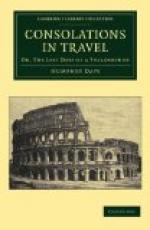In the beginning of October on a very fine afternoon I drove with these two friends to the Colosaeum, a monument which, for the hundredth time even, I had viewed with a new admiration; my friends partook of my sentiments. I shall give the conversation which occurred there in their own words. Onuphrio said, “How impressive are those ruins!—what a character do they give us of the ancient Romans, what magnificence of design, what grandeur of execution! Had we not historical documents to inform us of the period when this structure was raised and of the purposes for which it was designed, it might be imagined the work of a race of giants, a Council Chamber for those Titans fabled to have warred against the gods of the pagan mythology. The size of the masses of travertine of which it is composed is in harmony with the immense magnitude of the building. It is hardly to be wondered at that a people which constructed such works for their daily sports, for their usual amusements, should have possessed strength, enduring energy, and perseverance sufficient to enable them to conquer the world. They appear always to have formed their plans and made their combinations as if their power were beyond the reach of chance, independent of the influence of time, and founded for unlimited duration—for eternity!”
Ambrosio took up the discourse of Onuphrio, and said, “The aspect of this wonderful heap of ruins is so picturesque that it is impossible to regret its decay; and at this season of the year the colours of the vegetation are in harmony with those of the falling ruins, and how perfectly the whole landscape is in tone! The remains of the palace of the Caesars and of the golden halls of Nero appear in the distance, their gray and tottering turrets and their moss-stained arches reposing, as it were, upon the decaying vegetation: and there is nothing




